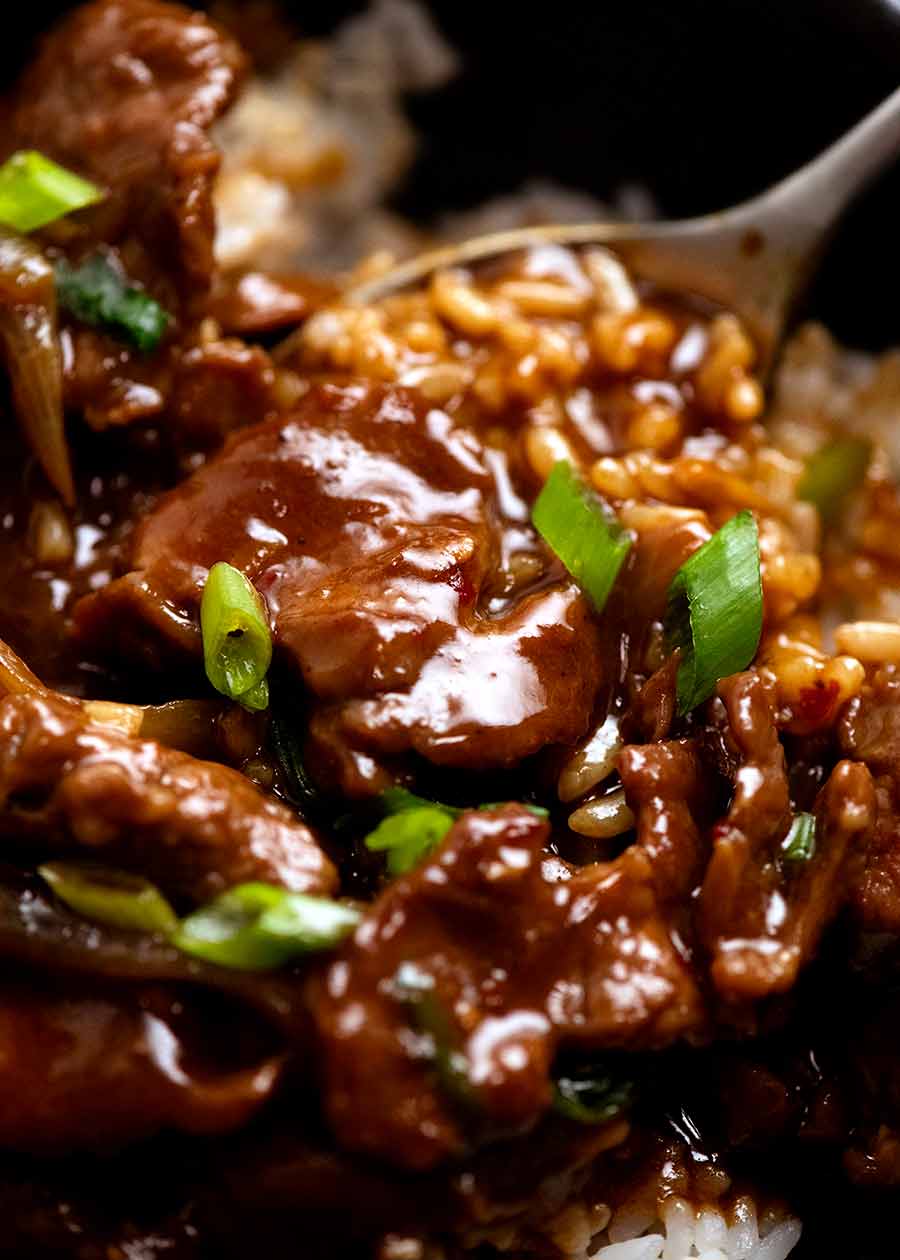
Mongolian Lamb is an Aussie favourite, found on the menu of every suburban Chinese restaurant. At “posher” establishments, it might even arrive at the table on a hot iron plate, sizzling and spitting for theatric effect!
Sizzle aside, this homemade version is a near perfect replica. Even the velveted texture of the lamb!

Mongolian Lamb
Mongolian Lamb is a Chinese stir fry that’s made with tenderised, marinated strips of lamb in a dark sweet-savoury sauce perfumed with Chinese Five Spice.
It’s not an authentic Chinese dish, and almost certainly has nothing to do with Mongolia. The truth is nobody really knows why it’s called Mongolian Lamb. But it’s a Chinese-Australian takeaway classic nonetheless that every Aussie knows and loves!
Is this the lamb version of American Mongolian Beef?
Nope! Different sauce – while the American Mongolian Beef is also sweet, it doesn’t have the hoisin five spice flavour. Also Mongolian Beef is typically crispy fried strips of beef. Both are equally delicious in different ways!
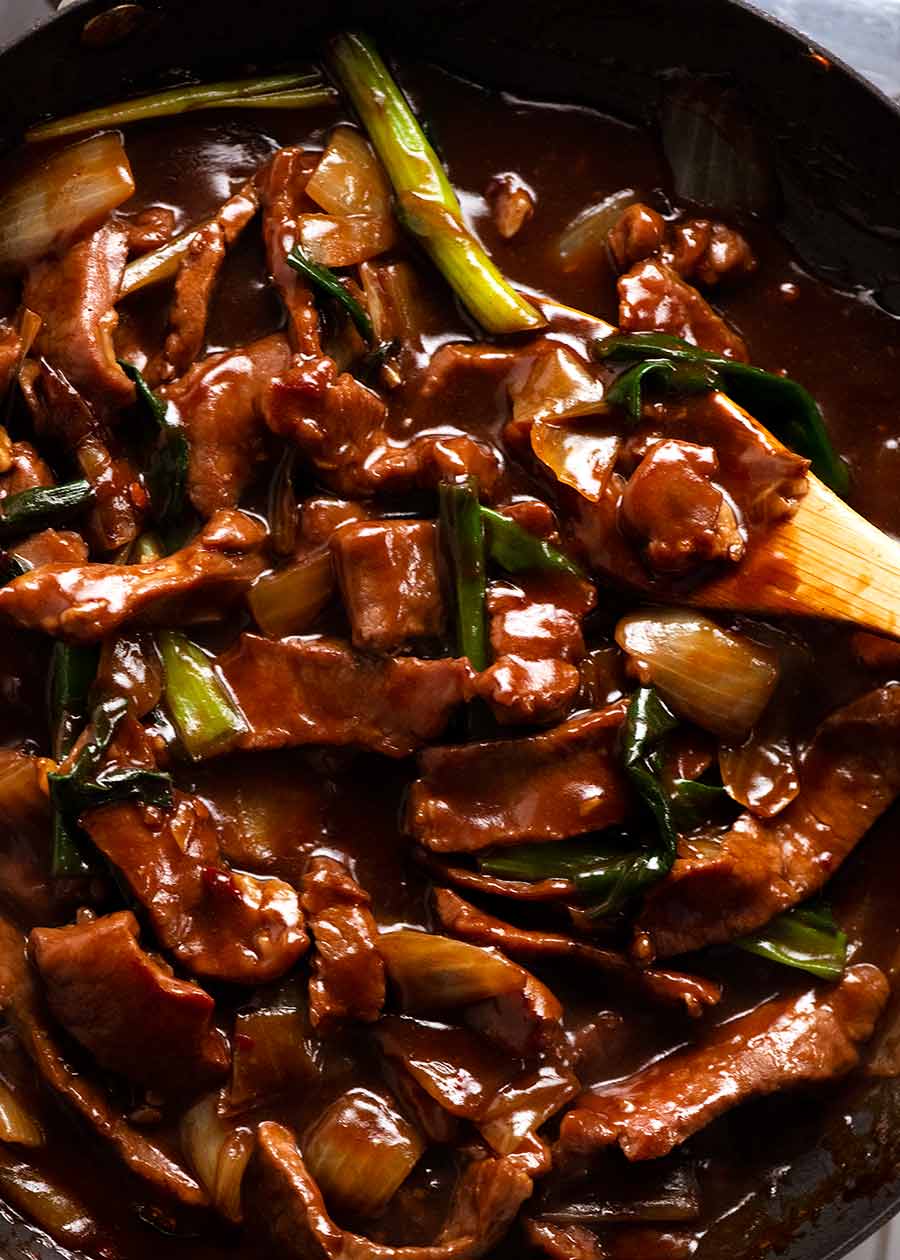
Restaurant copycat
Every restaurant does their Mongolian Lamb differently and there isn’t, to my knowledge, a standard recipe. This is our version, a copycat of the Mongolian Lamb we had as kids, when going out to the local Chinese restaurant for dinner was a rare and special treat!
Mongolian Lamb lovers – this will knock your socks off. I dare to say it’s a perfect replica (well, minus the cast iron pan sizzling!)
What goes in Mongolian Lamb Marinade
Here’s what you need for the Mongolian Lamb marinade which tenderises the lamb – Chinese restaurant style!
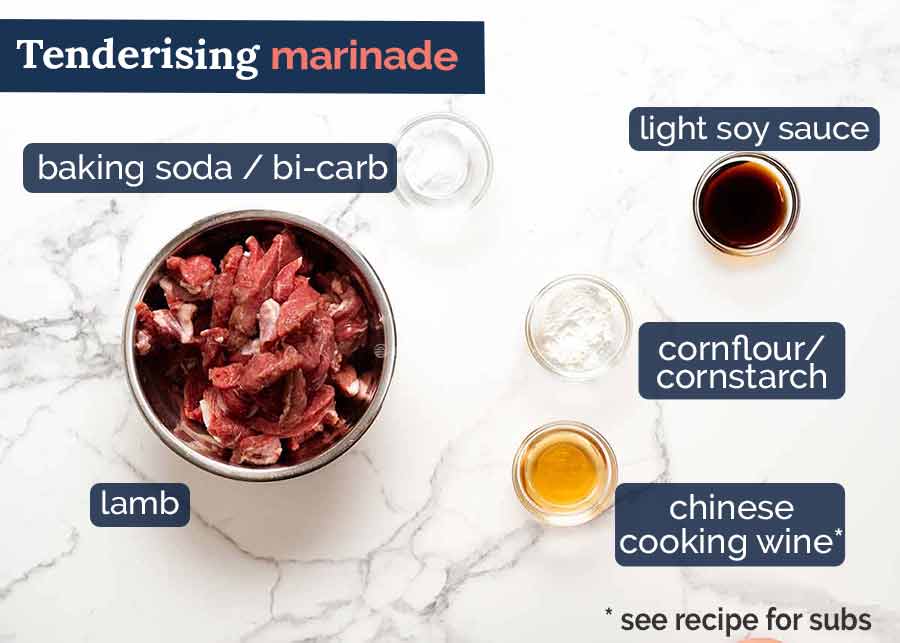
Best lamb for Mongolian Lamb
You can use expensive or cheap cuts because we tenderise the meat. Once cheap cuts like lamb shoulder which are tougher meats are tenderised/marinated for 24 hours, the texture is the same as more expensive cuts like lamb backstrap that have been marinated for 2 hours.
- My favourite – I like to use lamb loin chops (aka lamb midloin chops). They are a good mid-range cut that isn’t too off-the-charts expensive that only requires 2 hours tenderising time (even 1 hr is enough);
- “Posher” Chinese restaurants typically use Lamb Backstrap which is a a premium cut, $40/kg+ (A$20/lb); and
- Economical – Your everyday suburban restaurant typically uses economical cuts – lamb shoulder seems common. I like using lamb shoulder – I just use it less than loin chops because it requires overnight marinating.
Here’s a list of different lamb cuts and the marinating time required:
- More expensive, tender cuts of lamb (like backstrap, loin, midloin chops) are tenderised for just 2 hours; and
- Tougher, better value cuts of lamb (like shoulder, forequarter chops, lamb rump steak or roast, and anything generically labelled as “stewing” or “chuck”), require 24 hours of tenderising. Bonus: cheaper lamb cuts typically have better lamb flavour.
Why tenderise expensive, tender cuts of lamb?
Because the lamb is sliced thinly so it’s impossible to cook until “perfectly pink inside” like you do with any lamb chops or steaks. Tenderising gives the lamb that velvety, ultra moist, impossible to overcook texture of meat in Chinese dishes.
BEEF substitute
Absolutely sensational made with beef – and many Chinese restaurants offer beef versions of Mongolian Lamb. Tenderise the beef first (use any of the cuts recommended in that recipe) then just follow this recipe.
Baking soda / bi-carb and cornflour/cornstarch
These are the secret ingredients that tenderise the lamb meat. It’s a technique called “velveting” that is used in Chinese cooking, and it’s the reason why the meat in your favourite Chinese dishes are always so soft. Also used for chicken, beef and pork.
Mongolian Lamb Sauce ingredients
And here’s what you need for the Mongolian Lamb Sauce:
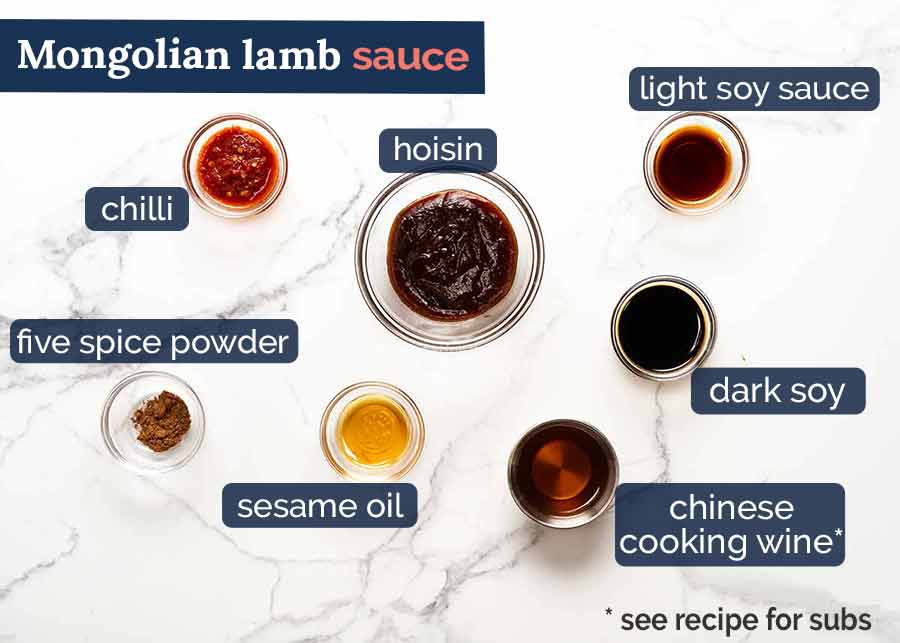
All the key ingredients here feature in Tier 1 of my Asian Market Shopping List!
- Chinese Five Spice Powder – a spice blend of five spices (shock horror!
 ), very common nowadays, sold at grocery stores and no more expensive than other spices. Also used in Chinese Beef and Broccoli, Chicken and Broccoli, Sticky Chinese Wings, Crispy Chinese Pork Belly. Search “five spice powder” for more recipes (pro tip: click “Ingredients” to see all recipes that use it);
), very common nowadays, sold at grocery stores and no more expensive than other spices. Also used in Chinese Beef and Broccoli, Chicken and Broccoli, Sticky Chinese Wings, Crispy Chinese Pork Belly. Search “five spice powder” for more recipes (pro tip: click “Ingredients” to see all recipes that use it); - Hoisin is a key flavouring ingredient for Mongolian Lamb Sauce. Sweet with savoury undertones, perfumed with Five Spice Powder, you’ll find it in the Asian aisle at any supermarket nowadays. Lee Kum Kee, Changs or Tung Chun are all good brands – AVOID Ayam. Wrong colour and flavour;
- Chinese cooking wine – essential for authentic Chinese restaurant sauces, and this recipe is no exception! Substitute with: dry sherry, Mirin or low sodium chicken stock/broth.
- Chilli paste – I like using Sambal Oelak or Chilli Garlic Sauce because both these have extra flavouring in them. But anything spicy will do – even Sriracha. This is not an overly spicy dish but Mongolian Lamb does have a bit of chilli in it;
- Dark soy sauce is what makes the sauce a deep mahogany colour and adds flavour, whereas light soy or all purpose soy sauce adds salt without colouring the sauce more. Read more about soy sauces – Soy Sauce; different types, when to use what, best substitutes; and
- Sesame oil – toasted, for better flavour.
What goes in the Mongolian Lamb stir fry
Just 3 simple things required for the stir fry!
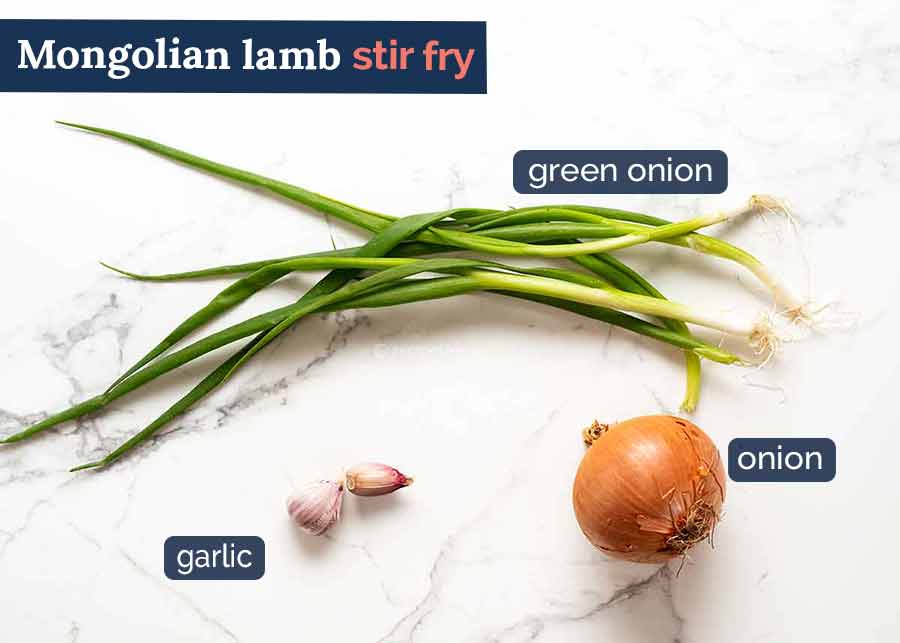
How to make Mongolian Lamb
Nice and simple: marinate the lamb, mix the sauce, then it all gets cooked in one wok or skillet in a matter of minutes!
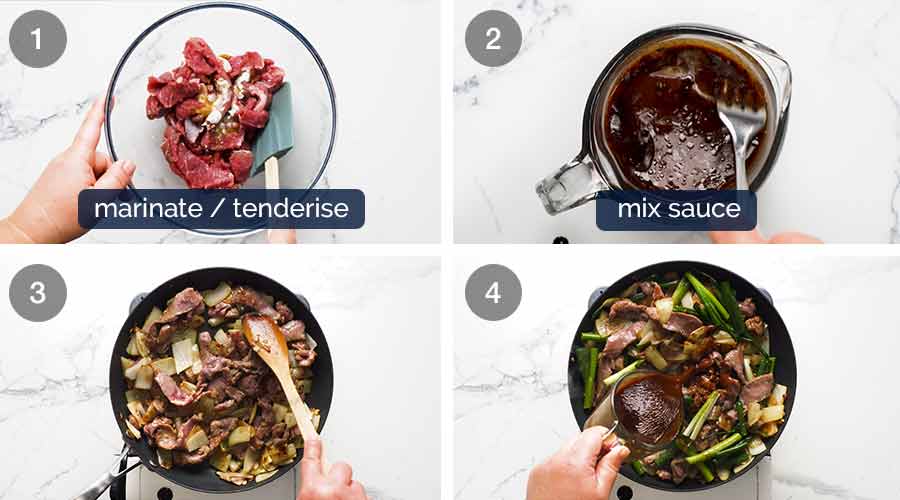
Once the sauce goes in, simmer for a minute or two until the sauce thickens beautifully, dark and glossy.
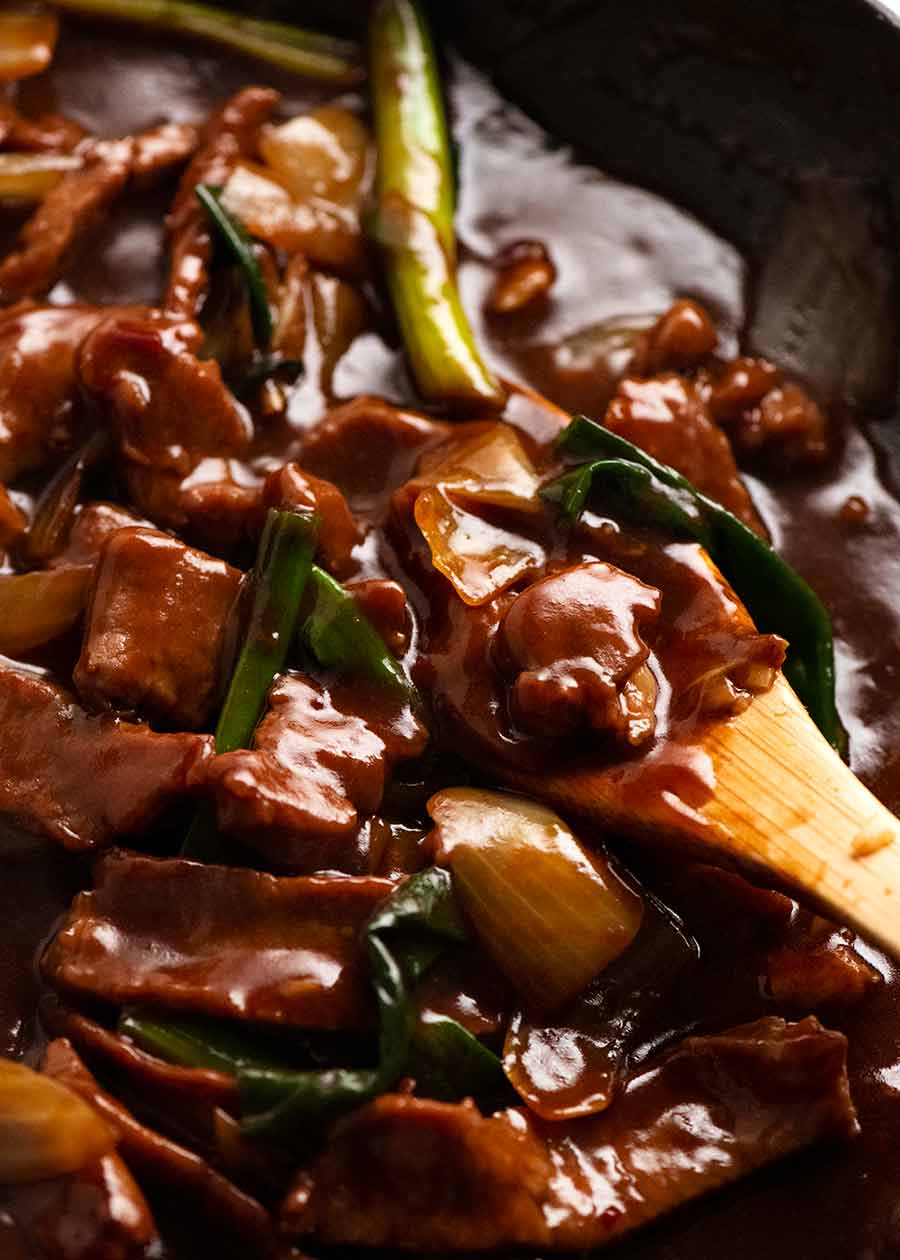
How to serve Mongolian Lamb
Rice is essential because it would be criminal not to be able to scoop up huge spoonfuls of rice soaked in that wickedly good Mongolian Lamb sauce. If you’re attempting the low carb thing (and believe me, I force myself onto that bandwagon every now and then), cauliflower rice is an excellent alternative though if you have the time, try Cauliflower Fried Rice instead (this makes low-carb infinitely more enjoyable).
For your vegetable quota, you could add around 2 cups of vegetables like carrots and zucchini chopped into batons into this stir fry. Cook them with the onion before adding the lamb as they will take longer to cook.
Don’t use broccoli or broccolini because they heads will soak up too much of the sauce. Sauce hogs!
Otherwise, just chop up fresh veggies or steam a pile of any vegetables and toss with Sesame Dressing. Excellent quick vegetable side option for all things Asian that I use regularly! – Nagi x
Watch how to make it
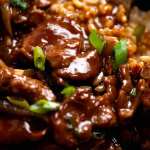
Mongolian Lamb
Ingredients
Lamb and marinade:
- 350g / 12 oz lamb meat (chops, backstrap, shoulder) , thinly sliced 2 - 3 mm / 1/10" (boneless weight, excess fat trimmed) (Note 1 for more cuts)
- 1/2 tsp baking soda (bicarb soda) (tenderiser, Note 2)
- 1 tsp cornflour / cornstarch
- 1 tbsp light soy sauce (or all purpose, Note 3)
- 1 tbsp Chinese cooking wine (Note 4 subs)
Sauce:
- 1 1/2 tsp Sambal Oelak or other chilli paste (or omit for no spice)
- 2 tbsp Chinese cooking wine (Note 4 subs)
- 3 tbsp hoisin sauce (I used Lee Kum Kee brand)
- 1/4 tsp five spice powder
- 2 tsp dark soy sauce (Note 3)
- 1 tsp light soy sauce (or all purpose, Note 3)
- 3/4 cup water
- 2 tsp cornflour / cornstarch
- 1 tsp sesame oil
Stir fry:
- 2 tbsp vegetable oil (or canola or peanut)
- 1 large onion , cut into large 2.5cm / 1" squares
- 2 cloves garlic , finely chopped
- 4 green onions , cut into 5cm/2" lengths
Instructions
Tenderise Lamb:
-
Combine lamb and marinade ingredients, mix very well. Cover and refrigerate to tenderise - use times below:
-
24 hour marinade - lamb shoulder, leg (steak or roast), forequarter chops, neck, rump (steak or roast), chump chop.
-
2 hour marinade: midloin chops, backstrap, loin, cutlets.
Cooking:
-
Sauce: Mix sauce ingredients together.
-
Cook onion: Heat oil over high heat in a wok or heavy based skillet. Add onions, and stir fry for 30 seconds until starting to colour. Add garlic and toss through quickly.
-
Cook Lamb: Add lamb and cook for 3 minutes until it all changes from red to brown, and some pieces start getting nice golden brown surfaces.
-
Add Sauce: Add green onions, stir for 10 seconds, then add Sauce. Stir and let simmer for 1 - 2 minutes until thickened.
-
Serve with rice!
Notes
- Mid loin chops (2 hr marinade)- my favourite for short marinade time, you will need about 650g/1.3lb bone in (you lose alot in bone and trimming excess fat);
- Shoulder (24 hr marinade) - my second favourite, used by typical suburban restaurants; and
- Backstrap (2 hr marinade) - only when on sale because it's expensive! Excellent lean meat option, used by posher Chinese restaurants.
Nutrition
Life of Dozer
When he somehow got in but couldn’t figure out how to get out. He cried like a girl until I saved him. 
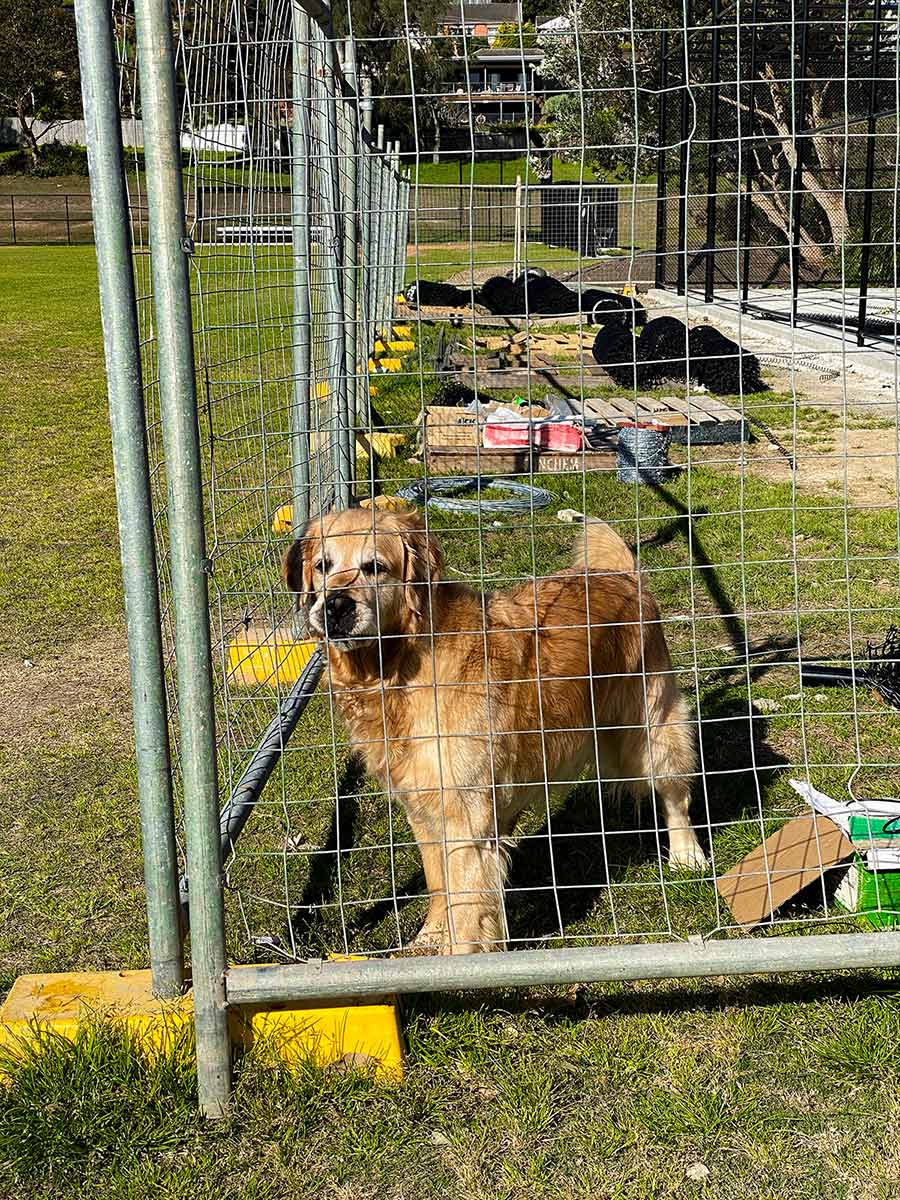
The post Mongolian Lamb appeared first on RecipeTin Eats.






0 comments:
Post a Comment